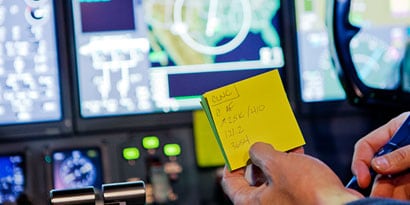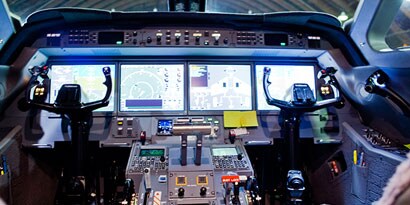
-
Ever wondered what pilots actually do before, during and after their flights? We did, too (and whether they use Post-it® Notes to help, just like the rest of us). As it turns out, they've got a lot to keep track of – and some clever ways to make sure they keep every flight safe.We climbed into the cockpit with Mark, a corporate pilot, to learn just what's required to get ready to fly, to keep things running smoothly and to prepare for a safe arrival.
-
First up? Check on the weather conditions for departure. When Mark gets ready for a flight, his first step is to get on the radio and find out the weather conditions at the airport the plane is leaving from – that means temperature, barometric pressure, precipitation, dew point and wind direction and strength. As he listens to all these figures, he writes them down on a Post-it® Super Sticky Notes, and, once it's complete, he sticks it onto the control panel where he and his co-pilot can see it at all times.


-
The next step is to call for a clearance – that means Mark gets on the radio to Air Traffic Control and requests a clearance. The air traffic controllers give him a flight path to follow, tell him the altitude at which he should be flying and give him a discrete code to make sure everyone stays on the same page. As Mark says, it's important to be safe, because, "There's a lot of sky out there, but there's also a lot of airplanes." And where does all that info go? On another Post-it® Note, of course.

-
Why all the Post-it® Super Sticky Notes when you could just print out the information? Because they stick. In fact, Mark explains it better than we can:
"What I like about these is that you stick 'em and they stick. Which sounds dumb, but sometimes this airplane's below freezing…or sometimes it's sitting in desert conditions where it's 50-some degrees Celsius – or 100+ Fahrenheit – outside, and the stuff still sticks, which is really nice. It makes our work environment a lot easier when we have the information we need readily available."
-
And once they're up in the air? Every plane has what's called a "squawk code" – a discrete ID, (think of a single use license plate number) that's continually broadcast from the plane and that identifies it to air traffic controllers so they can be sure where the plane is at all times. Of course, that doesn't take into account controlling the rudder, keeping the altimeter reading correct, maintaining the correct speed with the throttles, keeping an eye on the instruments and crew alerting system (the displays that show green [A-OK], yellow [something's wrong] or red [emergency]), or making sure there's enough fuel...

It's a lot to keep track of, but once you get the hang of it, it is, according to Mark, one of the most fun and rewarding jobs out there – not to mention an incredible ride! We like to think the Post-it® Super Sticky Notes are enjoying that ride, too.

